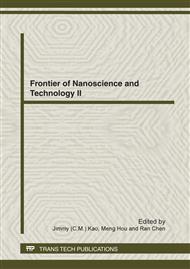p.245
p.249
p.254
p.259
p.263
p.267
p.272
p.277
p.281
Study on Surface Modification of Nano-Alumina with Silicane Coupling Agent KH550
Abstract:
Silane coupling agent KH550 was used to modify the surface of nano-alumina. Ultrasonic dispersion was employed to take the place of traditional mechanical stir. Absorbency of the aqueous solution of nano-Al2O3, which had been modified, was determined to confirm that under this process condition the optimum amount of KH550 was 2.5% while the optimum time was 50 minutes. The infrared spectra indicated that the surface of nano-Al2O3 had been modified and the absorption of KH550 really existed there.
Info:
Periodical:
Pages:
263-266
Citation:
Online since:
June 2012
Authors:
Price:
Сopyright:
© 2012 Trans Tech Publications Ltd. All Rights Reserved
Share:
Citation:


